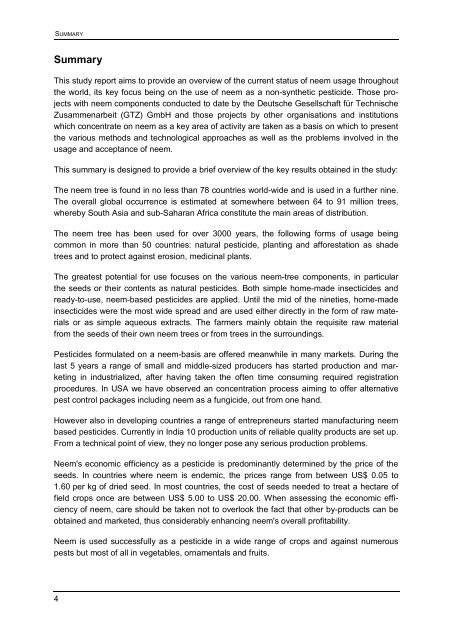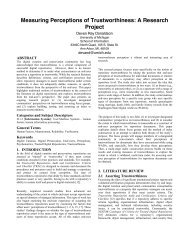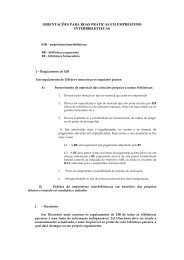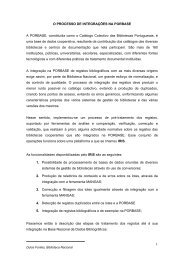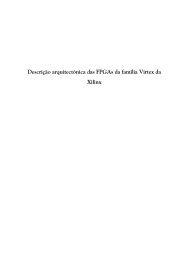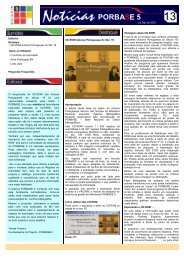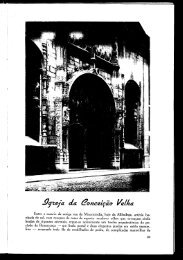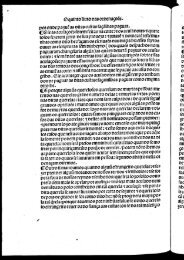Status report on global Neem usage - Biblioteca Nacional de Portugal
Status report on global Neem usage - Biblioteca Nacional de Portugal
Status report on global Neem usage - Biblioteca Nacional de Portugal
You also want an ePaper? Increase the reach of your titles
YUMPU automatically turns print PDFs into web optimized ePapers that Google loves.
SUMMARY<br />
Summary<br />
This study <str<strong>on</strong>g>report</str<strong>on</strong>g> aims to provi<strong>de</strong> an overview of the current status of neem <strong>usage</strong> throughout<br />
the world, its key focus being <strong>on</strong> the use of neem as a n<strong>on</strong>-synthetic pestici<strong>de</strong>. Those projects<br />
with neem comp<strong>on</strong>ents c<strong>on</strong>ducted to date by the Deutsche Gesellschaft für Technische<br />
Zusammenarbeit (GTZ) GmbH and those projects by other organisati<strong>on</strong>s and instituti<strong>on</strong>s<br />
which c<strong>on</strong>centrate <strong>on</strong> neem as a key area of activity are taken as a basis <strong>on</strong> which to present<br />
the various methods and technological approaches as well as the problems involved in the<br />
<strong>usage</strong> and acceptance of neem.<br />
This summary is <strong>de</strong>signed to provi<strong>de</strong> a brief overview of the key results obtained in the study:<br />
The neem tree is found in no less than 78 countries world-wi<strong>de</strong> and is used in a further nine.<br />
The overall <strong>global</strong> occurrence is estimated at somewhere between 64 to 91 milli<strong>on</strong> trees,<br />
whereby South Asia and sub-Saharan Africa c<strong>on</strong>stitute the main areas of distributi<strong>on</strong>.<br />
The neem tree has been used for over 3000 years, the following forms of <strong>usage</strong> being<br />
comm<strong>on</strong> in more than 50 countries: natural pestici<strong>de</strong>, planting and afforestati<strong>on</strong> as sha<strong>de</strong><br />
trees and to protect against erosi<strong>on</strong>, medicinal plants.<br />
The greatest potential for use focuses <strong>on</strong> the various neem-tree comp<strong>on</strong>ents, in particular<br />
the seeds or their c<strong>on</strong>tents as natural pestici<strong>de</strong>s. Both simple home-ma<strong>de</strong> insectici<strong>de</strong>s and<br />
ready-to-use, neem-based pestici<strong>de</strong>s are applied. Until the mid of the nineties, home-ma<strong>de</strong><br />
insectici<strong>de</strong>s were the most wi<strong>de</strong> spread and are used either directly in the form of raw materials<br />
or as simple aqueous extracts. The farmers mainly obtain the requisite raw material<br />
from the seeds of their own neem trees or from trees in the surroundings.<br />
Pestici<strong>de</strong>s formulated <strong>on</strong> a neem-basis are offered meanwhile in many markets. During the<br />
last 5 years a range of small and middle-sized producers has started producti<strong>on</strong> and marketing<br />
in industrialized, after having taken the often time c<strong>on</strong>suming required registrati<strong>on</strong><br />
procedures. In USA we have observed an c<strong>on</strong>centrati<strong>on</strong> process aiming to offer alternative<br />
pest c<strong>on</strong>trol packages including neem as a fungici<strong>de</strong>, out from <strong>on</strong>e hand.<br />
However also in <strong>de</strong>veloping countries a range of entrepreneurs started manufacturing neem<br />
based pestici<strong>de</strong>s. Currently in India 10 producti<strong>on</strong> units of reliable quality products are set up.<br />
From a technical point of view, they no l<strong>on</strong>ger pose any serious producti<strong>on</strong> problems.<br />
<strong>Neem</strong>'s ec<strong>on</strong>omic efficiency as a pestici<strong>de</strong> is predominantly <strong>de</strong>termined by the price of the<br />
seeds. In countries where neem is en<strong>de</strong>mic, the prices range from between US$ 0.05 to<br />
1.60 per kg of dried seed. In most countries, the cost of seeds nee<strong>de</strong>d to treat a hectare of<br />
field crops <strong>on</strong>ce are between US$ 5.00 to US$ 20.00. When assessing the ec<strong>on</strong>omic efficiency<br />
of neem, care should be taken not to overlook the fact that other by-products can be<br />
obtained and marketed, thus c<strong>on</strong>si<strong>de</strong>rably enhancing neem's overall profitability.<br />
<strong>Neem</strong> is used successfully as a pestici<strong>de</strong> in a wi<strong>de</strong> range of crops and against numerous<br />
pests but most of all in vegetables, ornamentals and fruits.<br />
4


